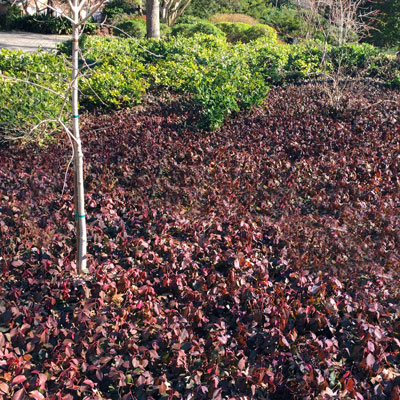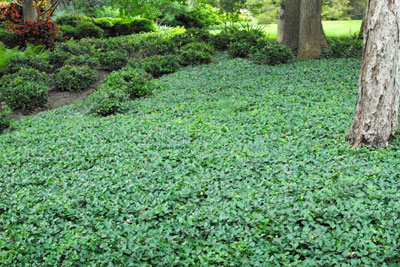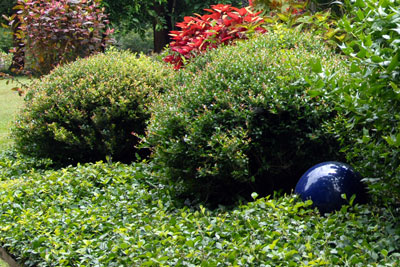Plant of the Week – Purple Wintercreeper Euonymus: March 14, 2019
If you were tooling an old-fashioned leather belt with this plant’s name across its back, it would go from buckle to tip. This baby has a whopper of a name. Too much for most people to remember.
“Howdy, Ma’am. I’m Purple Wintercreeper Euonymus, but my friends just call me ‘Wintercreeper’ for short.”

Maroon winter color is still showing in bed of purple wintercreeper euonymus in Sperry home landscape. This is a great Texas groundcover.
Botanically it’s Euonymus fortune ‘Coloratus,’ a selection of the species that’s noted for turning maroon in the cold weather of winter. Summer foliage, by comparison, is lustrously dark green.

From a slightly different angle, this is the rich green color of the same bed in the summer. Purple wintercreeper is no longer purple during the growing season. But it’s still a spectacular groundcover for sun or shade.
I bought a house for my mom back in the early 1980s. In landscaping it, there was a small bed that cried out for a groundcover. Tired of the conventional Asian jasmine, I saw two flats of purple wintercreeper and decided to give it a try. To my surprise, one flat was all that I needed. That bed did well and is probably still thriving today.
I brought the other flat home and set it on the ground outside the door to my greenhouse. It remained there (unplanted) for several years. I watered it each time that I watered my greenhouse, and the plants seemed to prosper. Finally I decided it was time to give them a home. I was developing a larger groundcover bed, and I had planned to move them to that area.
To my surprise, those plants were solidly rooted into the unimproved native North Texas clay, and today, 25 years later, supplemented by a few additional plants I bought to go alongside them, they’ve filled a very large bed.

Purple wintercreeper does just as well in full sun. This bed has thrived in our landscape for a decade or more.
I’ve used wintercreeper several other places in our landscape. We have probably half an acre of it in both full sun and full shade, and it does equally well in both settings. It’s completely winter-hardy to our North Texas cold, which gives it a leg up to Asian jasmine, and it wilts but doesn’t die in severe summer droughts. I’ve never had a serious insect or disease outbreak in any of my beds. This is one of the most durable plants I’ve ever grown.
I plant 4-inch pots 16 inches apart checkerboard-style into well-prepared garden soil (unlike what that first flat received). The first year they grow to cover the soil. The second year they begin to send new shoots up in a sprawling manner. I try to weave them back down rather than trimming them off. By the end of the second full growing season the plantings are developing their mature thickness of 4 to 5 inches. I keep my beds pruned at that height. I don’t want the plantings any thicker, and I don’t want them to start climbing trees and the side walls of our house.
If you’re looking for a failsafe Texas groundcover that will do you up proud, I’m happy to recommend this fine little beauty with a name as wide as our state.
